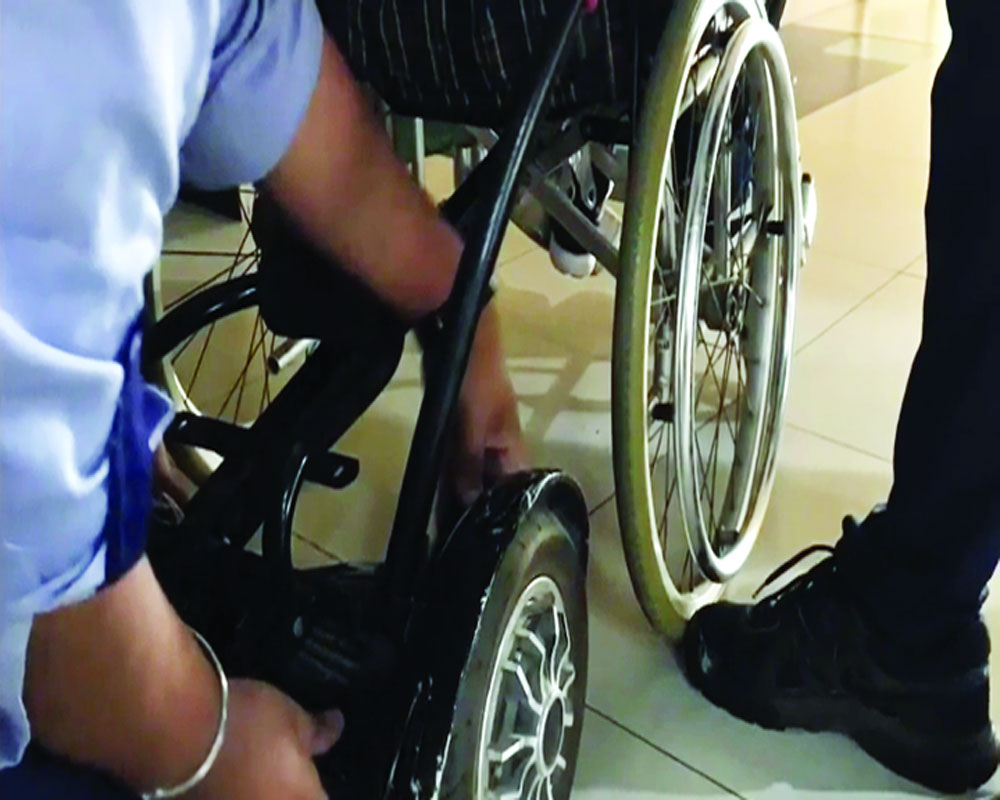There are 12 lakh wheelchair users in India. In order to make mobility easy for such people, a group of Class XI students of Shiv Nadar School, Gurugram have developed Hoverchair. SHALINI SAKSENA brings you a report
A recent estimate by the Union Labour Ministry’s National Sample Survey puts the number of people with locomotor disabilities in India at a staggering 16 million and a significant number are elderly and wheelchair-dependent. While there are wheelchairs for them to get by, most wheelchair-bound people will tell you that to manoeuvre it is a task given that they are heavy.
In order to make it easier for the physically-challenged and senior citizens independent a group of Class XI students of Shiv Nadar School- Gurugram (a not-for-profit initiative of the Shiv Nadar Foundation) have developed a special product — Hoverchair to make the lives of physically-challenged seniors easier. It is an innovative wheelchair that users can easily manoeuvre themselves and has novel features like speed-regulation and even music.
The team comprising Jasmehar Jubbal, Tanya Singh Yogi, Krsna Gaind, Prithvi Ramamurthy and Arshia Mago spent months on the project to make customised, congenial and cost-effective. One is told that the Hoverchair will be a boon to a consequential number of seniors and, by making them independent, restore their lost dignity. The idea was part of the school's Capstone project which is an annual conference that helps students identify problems plaguing the society and come up with ideas and products to address them.
“For the team, was struck and deeply saddened us was the state of the people bound to wheelchairs. They have to drive the wheelchairs manually and it is physically tiring since many of them cannot afford an electric wheelchair. One day when we saw one of our teammates using the hoverboard, we started exploring ways to combine a regular wheelchair with a hover-board to turn it into a low-cost electric wheelchair which can be made available to everyone at the lowest cost possible,†Jubbal recounts.
Ramamurthy tells you that it was not easy to build the Hoverchair structure. But they did it after putting the design on paper. It is built using metal, has a wide and comfortable cushioned seat with backrest along with a seatbelt for safety and precaution. The control levers are also metallic. It has rubber wheels on the front and rotatable metal footrests. To ensure quality, we had contacted a hoverboard manufacturer and with his help, we were able to build a frame using the manufacturing unit of Mahindra stiller. The frame was then attached to the hoverboard with simple mechanics in a way that it becomes an electrically assisted wheelchair,†Mago explains.
The hoverboard is designed to be a high-quality model that is extremely durable and can be used on roads and mud tracks as well. It has a battery that can run for up to 12 hours once fully charged. The hoverboard has a top speed of 10-15km/h which can be further calibrated.
During the testing of the prototype, many wheelchair-bound senior citizens found the Hoverchair to be light and easy to get by. A physically-challenged man was thrilled that soon there will be a better option available for them which is cost-effective. For now, the Hoverchair costs Rs 25,000 which is roughly half the market cost for the electric wheelchair. However, the team is looking at ways to bring down the cost even more and make it affordable even for middle class low middle-class people to be able to buy it. “We have done our best to keep the cost low and are trying to bring the price even lower. The electric wheelchairs in the market are expensive. We wanted to bring a wheelchair that is easy to get by and low on cost. The biggest advantage is affordability. We were able to design our version of electric wheelchair in half the current market cost while ensuring an equivalent level of comfort for the end user. We are now working towards making it foldable and reduce its weight further without increasing the costs which would turn this into an ideal product for everyone who needs it,†Yogi says.
The team has tested the Hoverchair for up to 100 kg weight and it has worked well. “Based on our estimation we think it can easily handle another 20 kg, Gaind tells you.
The team faced quite a few challenges. They had to work on multiple prototypes to arrive at the mechanical set-up which should feel like that it is one connected system between the chair and the hoverboard. “Our current challenge is that we need a way to reduce the chair's weight without increasing cost or losing strength and we are evaluating possible ways to do that. The COVID 19 has also been a major challenge in taking up our project ahead,†Gain says.
The team is now looking to pitch their product to existing automobile companies to figure out possible alignment. “Our intent is to make it even more cost-effective, so that is sustainable for the chosen target audience,†Ramamurthy says.


























